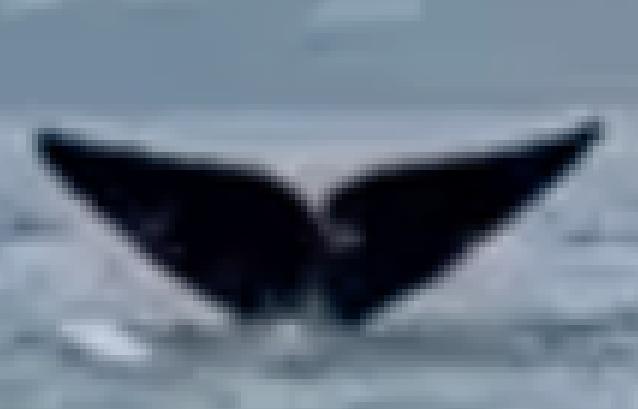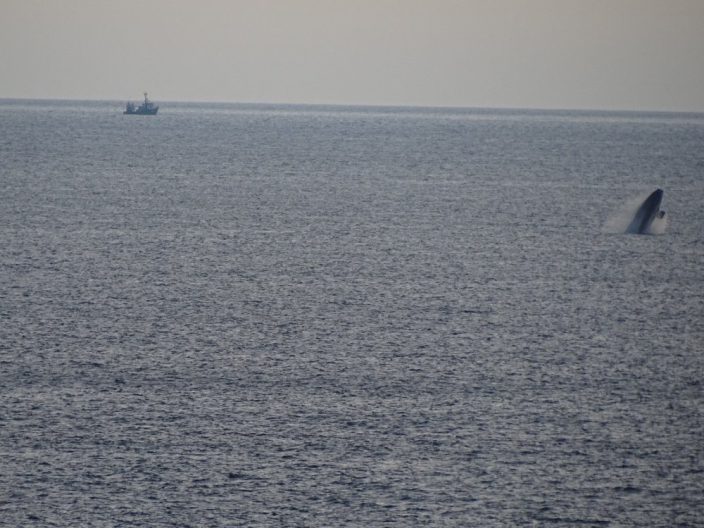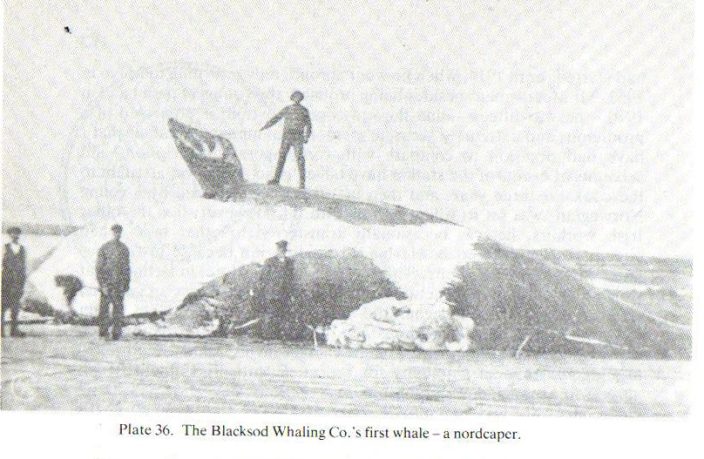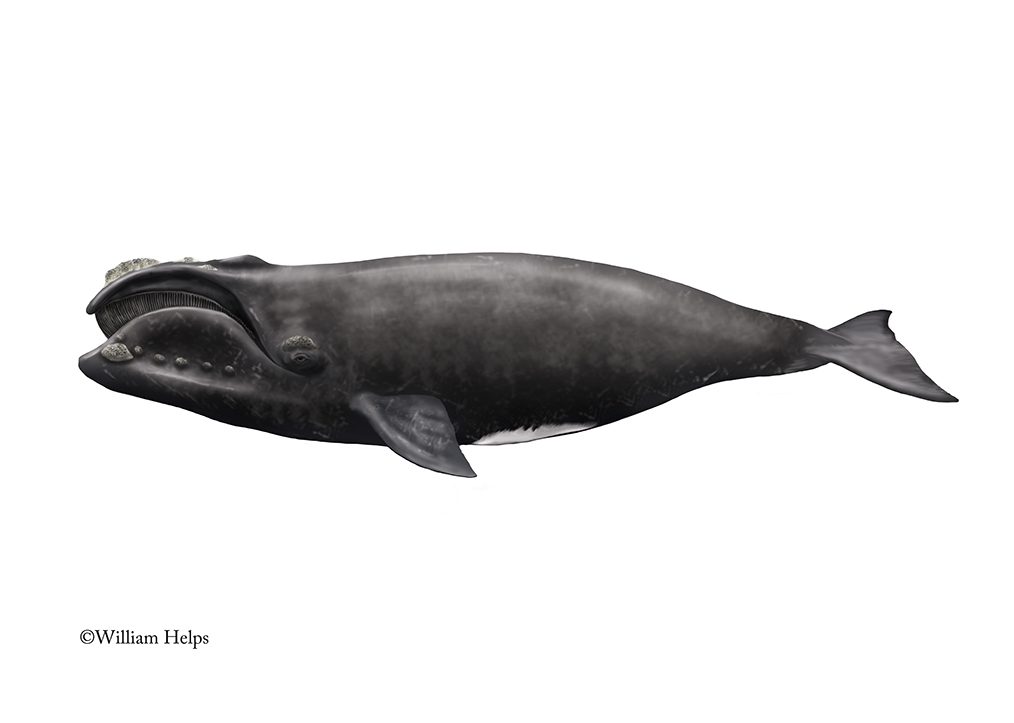Report update, August 20th, 2024
A month after the initial sighting a message was posted on the IWDG Facebook page from a Liam McKay, a US visitor from Massachusetts, telling us that on August 13th he watched a whale from the shore in the bay between Lower Cruit Island and Arranmore, Co. Donegal, at a range of around 500 m, which he was certain wasn’t a humpback and believed it to be a Northern right whale. Sometimes the more one questions the veracity of such reports the less convinced you become, but in this case the more validation we applied, the more compelling his account seemed. The fluke lifting clear of the water, the long periods of it “lying up” on the surface both seemed a good fit. We also have to factor in his 40 years’ experience watching whales, as he sees this species quite often from his Cape Cod home. Unfortunately, as there were no images, we’ll never be certain, and as always in these situations we err on the side of caution, and we do so in order to protect that one good data point that we can stand over.
With these two reports of a North Atlantic right whale, albeit the second one being a “probable”, both from Co. Donegal on July 15th and August 13th and only 70 km distant, we’d ask observers in northwest waters and Donegal in particular to be extra vigilant and to report any unusual whale sightings to IWDG either on www.iwdg.ie or our Reporting App with any images or video. In case you can be incentivised, we’ll give a complimentary IWDG hoodie along with a year’s free membership to the next person to confirm with photographic evidence, the presence and whereabouts of this pioneering right whale.
Report 1. July 16th, 2024
With the summer silly season upon us, you have to particularly careful about believing much of the content that appears on our social media feeds. The recent story of the great white shark off Salthill Galway is a case in point. Simply edit out the Aussie accents and hey presto it could as easily be the west of Ireland, as against Southern Australia. And irrespective as to how many shark experts RTE bring on to correct the narrative, whether it be mis or dis-information, the genie is out of the bottle and it can’t easily be put back in; as guess what… young audiences of 15-30 yrs don’t listen to Morning Ireland or Joe Duffy. They get their news from their phones. Never has the validation process in biological recording been more relevant.

The 1st fluke shot yesterday didn’t give us much to work on!
So when my phone notification went off last night @ 20:00 with a shared clip of a large whale tail- fluking from Donegal Bay on July 15th, I was immediately reminded to take note of the audio in case the boat was full of Australians! But no, all I could hear were Northern accents, Belfast to be exact. The backdrop was also good for the stunning landscape looked very similar to the north coast of the Bay near Sliabh Liag. So far so good. But what about the actual whale itself?
In situations like this, the first thing is to eliminate the usual suspects and in Irish coastal waters, the only whale that routinely lifts its tail clear of the water before a deep dive, is the humpback whale, and this clearly was no humpback. So not only could we rule out this species, but along with the humpback, we could eliminate minke, fin and sei whales, who simply don’t tail fluke.
The thing about whales in Ireland, in common with most places around the globe, is that there will only be a relatively short list of “usual suspects” in any one area, and if it’s not one of the top four or five, you soon start running out of road and heading for the bookshelf containing your whale guides, to research the more unusual offshore deep diving species, rare species, or extra-limital vagrants. Within the hour we had more clues, this time of the whale logging almost lifeless on the surface, again not something we see often among our rorquals.
With further reports and video clips coming in late last night, we had narrowed this down to one of two species, both belonging to the family of Right whales, and the binary option was the extremely rare and now functionally extinct North Atlantic Right whale Eubalaena glacialis or the bowhead whale Balaena mysticetus.

This image of the whale breaching off Muckross area left was compelling evidence that this was either a North Atlantic Right or a bowhead whale © Franca Van Der Veer
In situations where rare species are recorded, IWDG consult far and wide to make sure the information is accurate and so we shared the details with colleagues at the College of the Atlantic in Bar harbour, Maine, USA who in turn forwarded the images to the acknowledged Right whale authorities in the States at the New England Aquarium, who curate the North Atlantic Right Whale Photo ID catalogue and on viewing the very latest clips taken by Gerard Johnston this morning (July 16th), they have confirmed that this is indeed a North Atlantic Right whale.
This is an exceptionally rare record for the Eastern Atlantic, where this species has been largely absent for decades, if not longer. We can make a convincing arguement that the last positive identification of this species in Ireland dates back to 1910, when this old whaling image below was taken from Co. Mayo, some 114 years ago. Since then, there have been a few “possibles” and even fewer “probables”, but no “definites”, that is until July 15th. The clue is in their name … “right whale”, so called by the early whalers because they stayed close to the shore, were curious around boats and floated when killed. For all these reasons, they were the preferred target for the early whalers and much of the damage to the right whale population was already done by the early Basque whalers as far back as the 11th-15th century, long before the advent of modern steam ships and explosive harpoons.
Today, there sadly remains only a remnant population of c.350-400 individual North Atlantic Right Whales and almost all of these occur along the east coast of the United States, and the outlook for their survival isn’t a good one, as both ship strike and entanglement in fishing gear remove individuals from a dwindling population annually.
So what do we read into the presence of this rare visitor in Donegal Bay? Well, we know that historically this species once existed in Irish waters, how many we don’t know. But James Fairley’s authoritative book “ Irish Whales and Whaling” has this important image of a Nordcaper or Biscayne whale (their old name) on the flensing deck of the Blacksod Whaling company on the Mullet Peninsula, Co. Mayo, which dates back to a period between 1908-1910. What we do know about them today, we could write on the back of a postage stamp, as for instance in the almost 35 years since the IWDG was established in 1990, we have never once confirmed a single sighting or stranding of this leviathan. That said, IWDG has no monopoly on whale records in Ireland, but as the largest cetacean data holder in the country, one would reasonably expect that if they were out there, even in low numbers, that at least one would have appeared among our records. So this weeks Donegal Bay record is the only sighting record on the IWDG database verified with photo-documentation.

Ireland played its part in the demise of the Northern Right whale. Image from Norwegian owned Blacksod whaling station, Mayo C.1908-1910
As always we ask wildlife and whale enthusiasts who’d like to visit the area with a view to seeing this animal to look for it and watch it from the shore using optics. North Atlantic Right whales are most susceptible to ship strike and even a collision with a small vessel can have fatal consequences for the individual and a significant impact at population level. There is an enormous onus on us all to ensure this whale remains as long as it needs in Donegal bay, where it’s most likely feeding on tiny copepods, without having to run the gauntlet of small craft and sightseers. As with all whales, they have full protection under Irish law under in the Irish Wildlife Act and Marine Notice 15 of 2005 which sets out the “Guidelines for Correct Procedures When Encountering Whales and Dolphins in Irish Coastal Waters.”
This is our chance to help a population of whales on the very brink. Please give it space.
Final determination of species made by this clip taken yesterday from Drumanoo Hd. Nr. Killybegs July 15th, 2024, which clearly show the individually unique pattern of callosities or raised knobby white patches on the head formed by colonies of whale lice. Video courtesy of Gerard Johnston
IWDG extend a big thank you to everyone in Donegal who initially reported this animal and helped us confirm its identity by forwarding images and video (Derek McGinley, Franca Van Der Veer, Michael Galvin, Gerard Johnston & Naomi Darcy) and to our colleagues at College of the Atlantic (Lindsey Jones), NOAA (Fred Wenzel) and the New England Aquarium who curate the North Atlantic Right Whale Photo ID Catalogue (Monica Zani, Philip Hamilton & Amy Knowlton) and last but not least Peter Evans of Seawatch Foundation, UK.
Also a special shout out to IWDG’s Brendan Quinn who was first shown the footage yesterday, and thought… there’s something a little odd about this whale!
By Pádraig Whooley,
IWDG Sightings Officer
Very different to a tail fluking humpack, © Naomi D’arcy

